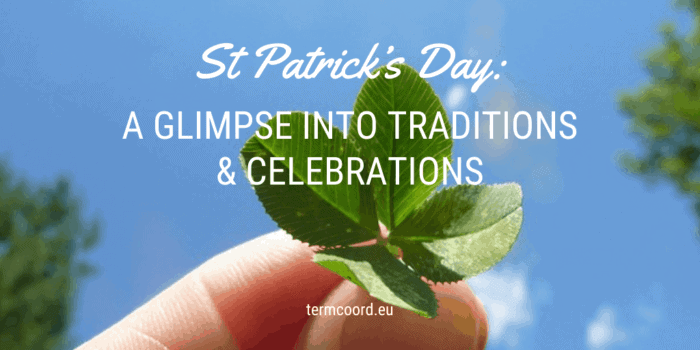Lá fhéile Pádraig sona dhuit!
If you hear that, it means there is an Irish speaker in the neighbourhood today and is wishing you ‘Happy Saint Patrick’s Day’!

March 17th is a special date for Irish: it’s the annual celebration of Saint Patrick, the patron saint of Ireland. This tradition sees its origins back in the 5th century AD in Britain, when Patrick was kidnapped and taken as a slave to Ireland where he was working as a shepherd until he managed to escape. He then got a holy vision that lead him to take vowels as a priest and return to Ireland to convert pagans to Christianity. It is claimed that he died on March 17th, 461 A.D., hence Saint Patrick’s Day falls on this day. After his death, legends started to grow around his figure. According to myth, Patrick would have used the three-leaf clover called shamrock (famous Irish symbol) to explain the Trinity. From this, Irish people started to wear the shamrock on Patrick’s commemoration day to symbolise their devotion and faith. Lately, this tradition grew into wearing green clothing, from the colour of the shamrock. Another famous Irish legend is the one relating to Leprechauns. Centre of the Irish folklore, Leprechauns are described as tiny creatures known to be sly, irritable, elusive yet mischievous. These miniature men wear green clothes, probably to camouflage into grass and leaves. In the United States, a legend says that wearing a green custom on March 17th makes you invisible to leprechauns, who therefore can’t pinch you. From this story, North-Americans pinch green-abstainers during Saint Patrick’s Day as a reminder of leprechauns’ disapproval of such non-green apparel. This is actually an American-based tradition born in the 18th century, since leprechauns were originally imagined to wear red clothes.
 Nowadays celebrations of Saint Patrick’s Day include religious observances as well as street parades, eating and drinking. In Dublin, this festivity is not just a single-day celebration but a four-day festival. You can breathe this festive atmosphere everywhere around the city: the streets swarm with tourists and take colour from the picturesque green, white and orange masks inspired by the colour of the Irish flag. Big crowds follow the parade crossing the entire city: starting from O’Connell Street, one the main street of Dublin where the Spire monument is located, the floats pass along the Liffey River and find their way through the city reaching Saint Patrick’s Cathedral. In every corner you can find people enjoying a pint of Guinness and listening to traditional Irish songs. This year’s theme is Ireland you are, an homage to the culturally diverse and complex society of Ireland.
Nowadays celebrations of Saint Patrick’s Day include religious observances as well as street parades, eating and drinking. In Dublin, this festivity is not just a single-day celebration but a four-day festival. You can breathe this festive atmosphere everywhere around the city: the streets swarm with tourists and take colour from the picturesque green, white and orange masks inspired by the colour of the Irish flag. Big crowds follow the parade crossing the entire city: starting from O’Connell Street, one the main street of Dublin where the Spire monument is located, the floats pass along the Liffey River and find their way through the city reaching Saint Patrick’s Cathedral. In every corner you can find people enjoying a pint of Guinness and listening to traditional Irish songs. This year’s theme is Ireland you are, an homage to the culturally diverse and complex society of Ireland.
 Can’t ye make it to go to the Emerald Isle? Don’t worry! Saint Patrick’s Day is widely recognised and celebrated all over the world, especially throughout the United States due to the largest presence of Irish communities overseas. Indeed, back to 1840s, the Great Famine caused a significant mass migration of thousands of Irish people, mainly towards the US. It’s here where nowadays some of the biggest celebrations of Saint Patrick’s Day take place. New York holds the most famous and largest street parade; Boston, which hosted the very first parade in 18th Century, still organises one of the biggest events outside Ireland; finally, Chicago River goes green through a vegetable dye that creates an impressive effect for spectators.
Can’t ye make it to go to the Emerald Isle? Don’t worry! Saint Patrick’s Day is widely recognised and celebrated all over the world, especially throughout the United States due to the largest presence of Irish communities overseas. Indeed, back to 1840s, the Great Famine caused a significant mass migration of thousands of Irish people, mainly towards the US. It’s here where nowadays some of the biggest celebrations of Saint Patrick’s Day take place. New York holds the most famous and largest street parade; Boston, which hosted the very first parade in 18th Century, still organises one of the biggest events outside Ireland; finally, Chicago River goes green through a vegetable dye that creates an impressive effect for spectators.
Well, now that you know a bit more about Saint Patrick’s history, traditions and celebrations around the globe you should be more than ready to celebrate it from wherever you are!
TermCoord wishes you all a happy Saint Patrick’s Day … ‘Lá fhéile Pádraig sona dhaoibh!’
Written by Giulia Mattoni. Translator and Terminologist. Terminology trainee at DG TRAD, Terminology Coordination Unit.
SOURCES
- Berry, Allison (2012) “Happy St. Patrick’s Day! A Brief History of Leprechauns”, Time Magazine. Available at: http://ti.me/2ngJ9N5 (Accessed: 17 March 2017)
- Hanrahan, Kathy (2017) “6 essential St. Patrick’s Day traditions, myths and more”, WRAL.com. Available at: http://bit.ly/2mzxBQL (Accessed: 17 March 2017)
- History Channel (n.d.) St Patrick’s Day. Available at: http://bit.ly/2m9AoVg (Accessed: 17 March 2017)
- St. Patrick’s Festival (2017) St. Patrick’s Festival Celebrates ‘Ireland You Are’ Across 4 Days. Available at: http://bit.ly/2mPY4el (Accessed: 17 March 2017)
- Tufayel, Ahmed (2016) “St Patrick’s Day 2016: How the World Will Celebrate from Dublin to Tokyo”, Newsweek. Available at: http://bit.ly/2nM4L0n (Accessed: 17 March 2017)

